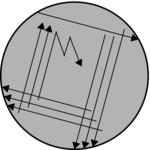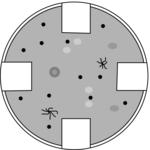Nitrogen-fixing bacteria in root nodules of leguminous plants
Class practical
In this activity, students will culture nitrogen-fixing bacteria from root nodules of leguminous plants. This will reinforce understanding of the role of bacteria in the nitrogen cycle and explore an example of symbiosis or mutualism.
 This practical is based on an investigation called published in Practical Microbiology for Secondary Schools © Society for General Microbiology.
This practical is based on an investigation called published in Practical Microbiology for Secondary Schools © Society for General Microbiology.
Lesson organisation
Make students aware of procedures for safe handling of microbial material when dealing with their incubated plates.
You may be able to set up this investigation alongside the investigation of nitrogen-fixing microbes from soil in the same lesson. If so, make sure the students do not confuse the plates of different media from the two activities.
Advance planning is needed to make sure suitable plant material is available – either grown from seed or dug from school field or lawns.
Apparatus and Chemicals
For each group of students:
Mannitol yeast extract agar plate, 1 (Note 2)
Sterile Petri dish, 1
Root mass from leguminous plant (Note 4)
Ethanol (IDA), 70% (v/v) to sterilise roots and apparatus (Note 5)
Bottle of sterile water, 1
Pasteur (dropping) pipette, 2
Bunsen burner, 1
Forceps, 1
Blunt glass rod, 1
Marker pen
Adhesive tape
For the class – set up by technician/ teacher:
Agar plate, mannitol yeast extract agar (MYEA), to be left untouched as a control, 1 (Note 1)
Suitable disinfectant solution for work area and discard pots (Note 2)
Leguminous plants with root nodules (Note 3)
Health & Safety and Technical notes
Carry out a full risk assessment before planning any work in microbiology (see Note 1 for more details).
Check the standard techniques for more details of Making nutrient agars, Pouring an agar plate, Aseptic technique and Incubating and viewing plates.
When using ethanol (see Note 4) to sterilise the roots and apparatus, take great care not to ignite spills or the source container. Keep the ethanol at least 1 metre away from the Bunsen burner and cover the container with, for example, aluminium foil. Be ready with a fire blanket in case of an ethanol fire. Brief students how to react calmly and safely to small fires.
1 Before embarking on any practical microbiological investigation carry out a full risk assessment. For detailed safety information on the use of microorganisms in schools and colleges, refer to Basic Practical Microbiology – A Manual (BPM) which is available, free, from the Society for General Microbiology (email This email address is being protected from spambots. You need JavaScript enabled to view it.) or go to the safety area of the SGM website http://www.microbiologyonline.org.uk/teachers/safety-information, or refer to the CLEAPSS Laboratory Handbook, section 15.
2 See Standard technique: Making up nutrient agars and refer to CLEAPSS Recipe card. Weigh out the dry powder in a fume cupboard to reduce the risk of inhalation. Wear heatproof gloves to handle vessels of hot liquid. For 1 litre of mannitol yeast extract agar medium (MYEA) suspend 10g agar in 1 litre of water. Heat to dissolve. Add 0.5 g K2HPO4 (see CLEAPSS Hazcard), 0.2 g MgSO4.7 H2O (see CLEAPSS Hazcard), 0.2 g NaCl (see CLEAPSS Hazcard), 0.2 g CaCl2.6H2O (see CLEAPSS Hazcard), 10 g mannitol and 0.4 g yeast extract. K2HPO4, MgSO4.7H2O and NaCl are described as LOW HAZARD. CaCl2.6H2O is an irritant as a powder, but not in the final medium. Mannitol and yeast extract are LOW HAZARD.
3 Suitable disinfectants include sodium chlorate(I) (hypochlorite) at concentrations greater than 1% (see CLEAPSS Hazcard), or Virkon used according to manufacturer’s instructions. Wear eye protection when handling disinfectants.
4 Roots – Any leguminous plant (peas, beans or clover) will have nodules. Clover is recommended since the nodules are relatively soft. You can grow clover from seed or dig it from a lawn or field.
5 Ethanol (IDA) – use 70% (v/v) industrial denatured alcohol to sterilise the apparatus and root material. Hazcard 40A describes this as highly flammable (flash point 13°C) and harmful (because of presence of methanol).
Ethical issues
There are no ethical issues associated with this procedure. Clover is a common plant in the UK.
Procedure
SAFETY:
Take care with ethanol and be prepared to deal calmly with small fires.
Take precautions to make sure living cultures remain closed.
Wear eye protection when handling disinfectants.
Preparation
a Calculate the quantity required. Prepare just enough agar medium for the investigation (12-15 cm3 for normal depth in a 90 mm Petri dish). Any surplus will keep for 6-12 months in tightly-sealed screw-top bottles if sterile and stored out of direct sunlight.
b Prepare mannitol yeast extract agar medium (MYEA) using the recipe above (Note 2). See Standard technique Making up nutrient agars.
c Distribute the agar medium into individual McCartney bottles and sterilise them if you want the students to pour their own plates. See Standard technique Pouring an agar plate.
d Prepare a suitable solution to disinfect the work area for the investigation and afterwards (Note 3). Students should wear eye protection.
Investigation
a Leave one plate unopened as a control.
b Collect a mannitol yeast extract agar plate. Label with your initials, date and ‘Root nodules’.
c Collect a plant. Choose a length of root with pink nodules and cut off a 1 cm portion using a scalpel (Note 4). Hold the root with forceps; rinse off adhering soil using tap water.

d Transfer several drops of ethanol (IDA) 70% (v/v) (Note 5) to a sterile Petri dish using a Pasteur (dropping) pipette with a teat. Put the pipette into your discard pot.
e Put the washed root into this ethanol using sterile forceps; leave immersed for 1-2 minutes.
f Use aseptic technique from here onwards - see Standard technique Aseptic techniques. Transfer enough sterile water to cover the base of a sterile Petri dish, using a sterile Pasteur pipette and teat. Keep the pipette sterile for later use by resting it under the lid of another sterile Petri dish.
g Sterilise forceps by dipping in ethanol (IDA), then quickly flaming and allowing to cool. Use the forcepts to transfer the root to the sterile water and rinse off the ethanol. Repeat this twice more with fresh sterile water.
h Transfer a few drops of sterile water to another sterile Petri dish. Add the portion of root using sterile forceps. Macerate (mash) the nodules with the forceps or a sterile glass rod to produce a milky fluid.
i Sterilise a wire loop by flaming, take a loopful of macerated nodules, and make a streak on the MYEA medium plate . Flame the loop again. See also Standard technique Making a streak plate.
j Tape plates closed before incubating with the base uppermost at 20-25°C for 2-3 days.

k Next lesson, study the colonies on the plate. Do not open the plate. See Incubating and viewing plates.
Teaching notes
Rhizobium can fix nitrogen only in conditions such as those prevailing in a root nodule. These are very difficult to reproduce in the laboratory. Therefore the aim is to remove all microbes from outside nodule by chemical sterilisation. Then to grow Rhizobium by inoculating a fixed nitrogen-containing culture medium with a sample taken from inside the root nodule.
Rhizobium fixes gaseous nitrogen from the air into compounds plants can use to help them grow. An enzyme complex called nitrogenase catalyses this reaction. Nitrogenase activity is sensitive to the presence of oxygen. Root nodules may appear pink because they contain leghaemoglobin. This is the only haemoglobin found in plants. It absorbs oxygen and provides anaerobic conditions for bacteria in the root nodules.
Rhizobium is a facultative anaerobe – it can grow without oxygen. It can fix nitrogen only in anaerobic conditions. It is usually considered to be an obligate mutualist when fixing nitrogen in the root nodule. It can be grown when not in a root nodule on a that containing a source of fixed nitrogen and a source of carbon and energy. These sources are provided in the MYEA medium by yeast extract (nitrogen) and Mannitol (carbon and energy).
Rhizobium can also grow free-living in soil although not fixing nitrogen. Commercial legume seeds are often coated with these organisms. In soil the cells are rod-shaped (as when growing on MYEA medium), whereas in the nodule and when fixing nitrogen they are Y-shaped, known as ‘bacteroids’.
The nitrogen fixed by bacteria in root nodules will fertilise the soil. This happens when organic nitrogen compounds diffuse from plant material dispersed after death or eaten by animals, or after seed dispersal.
Health & Safety checked, June 2009
Downloads
Download the student sheet ![]() Nitrogen-fixing bacteria in root nodules of leguminous plants (191 KB) with questions and answers.
Nitrogen-fixing bacteria in root nodules of leguminous plants (191 KB) with questions and answers.
Web links
www.microbiologyonline.org.uk/teachers/resources
Society for General Microbiology – source of Basic Practical Microbiology, an excellent manual of laboratory techniques and publishers of Practical Microbiology for Secondary Schools, a selection of tried and tested practicals using microorganisms. (Last accessed June 2008.)
(Websites accessed October 2011)


